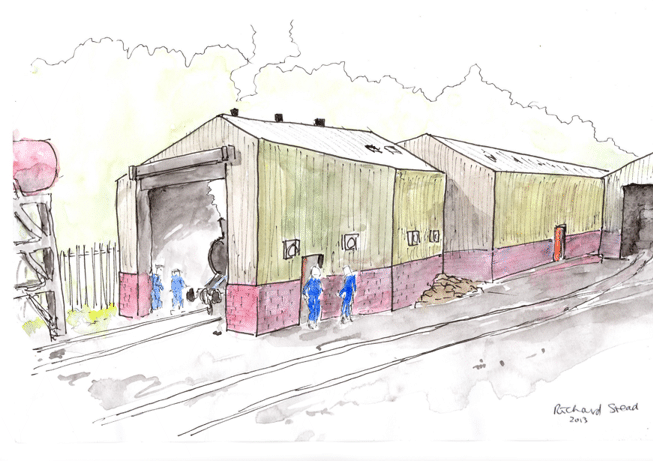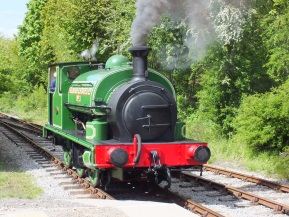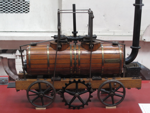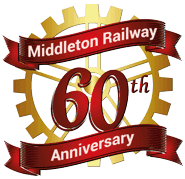What's a Running Shed?
A Running Shed is a building where we can both prepare steam and diesel locomotives for service indoors, and carry out light maintenance work on them. We will be building a shed that will be large enough to accommodate two operational locomotives. Here is an artist's impression of the planned shed, painted by Richard Stead, one of our members.

Why do we need a Running Shed?
Currently we have to prepare locomotives for service outdoors, which means they have to be stored outdoors for at least a few days before they are used. The Running Shed is being designed so that preparing locomotives, and carrying out running repairs on them, can all be done indoors. This will make the work far more comfortable, and will greatly improve the security of the locomotives.
This means that the Running Shed will better preserve our collection of locomotives, so as to allow us to keep them in the kind of condition illustrated below. As such it will help to ensure that the collection lasts for many more years into the future. The Running Shed will also give us more space in the yard and enable a better operating railway!

How will the Running Shed be built?
As the artist's impression above shows, the lower part of the walls of the running shed will be of brick construction, and the upper parts and roof will be of coated steel sheet (sometimes called "wriggly tin" by builders, although it is actually not tin at all!). The whole structure will be supported by a steel frame, which will rest on concrete foundations.
The shed can not be quite rectangular, because the site tapers (the two tracks shown in the impression merge at a turnout off to the left of the picture), and so the corner nearest the viewer has to taper off too. The shed will have smoke troughs and vents in the roof, so that the fumes produced while lighting the fires in steam locomotives can escape easily. Inside the shed there will be a pit between the rails, to make it easy to prepare locomotives, and there will also be another pit between the rails outside it (which is not shown in the impression), to simplify disposing of ash from steam locomotive fireboxes at the end of a day's operation.
These requirements mean that the process of constructing the shed will actually involve seven phases. A separate page describes how the project is structured, and the details of these phases.
When will the Running Shed be built?
Part of the answer to this is "when we have raised enough money to start", but the other part of the answer is that how long the work will take will depend on how much of it we do ourselves and how much is done by contractors. Doing the work ourselves, using our volunteer labour, is obviously cheaper than having to employ contractors, but it is also significantly slower. Some parts of the work do, however, need to be done by skilled contractors: erecting steel frames or fixing cladding sheets to them, possibly 15 feet up in the air, is not a task for amateurs! On the other hand, laying the bricks for the walls is something that we know our volunteers can do, although offers of help from experienced bricklayers would certainly be welcome!
A separate page describes the progress that we have made so far, and then other pages give more details of the work that has been done for individual phases of the project. We had hoped to see the project more-or-less finished by the end of 2016, but it actually ran on until nearly the end of 2017, and then we organised an opening ceremony in 2018.
How can you help?
There are two main ways in which you might be able to contribute to this project.
Firstly, even doing as much of the work ourselves as we can, we shall still need to raise quite a lot of money to build the Running Shed: the initial estimate was at least £46,000, and that has now gone up to about £48.000. A separate page describes the "Buy a Brick" appeal that we were running, to help raise funds to cover this cost, but this appeal has now closed.
Secondly, the parts that we can do ourselves will involve our volunteers working in all sorts of ways to contribute to the project. You can see some of these ways in the separate pages describing the work that has been done so far; there was a lot of bricklaying involved; we still have a floor to lay; we shall be installing all the electrical wiring and other fittings; and so on. If you have almost any kind of practical skill we will probably be able to use your help in this project. Please see our separate membership page for more details of how to get involved.
Go on to the next stage in this project.
More Information
Pages about other projects:
- Last Coals to Leeds;
- Raising Steam in No. 6;
- Project Phoenix;
- Overhauling "Brookes No. 1";
- Conserving "Picton".
Other pages provide more information about:








